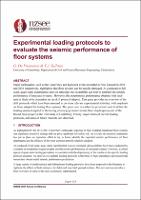| dc.contributor.author | De Francesco, Giovanni | |
| dc.contributor.author | Sullivan, Timothy | |
| dc.date.accessioned | 2021-06-22T04:01:52Z | |
| dc.date.available | 2021-06-22T04:01:52Z | |
| dc.date.issued | 2021-04-14 | |
| dc.identifier.uri | https://repo.nzsee.org.nz/xmlui/handle/nzsee/2354 | |
| dc.description.abstract | Major earthquakes, such as the Canterbury and Kaikoura events recorded in New Zealand in 2010 and 2016 respectively, highlighted that floor systems can be heavily damaged. At a reduced or full scale, quasi-static experimental tests on structural sub-assemblies can help to establish the seismic performance of structural systems. However, the experimental performance obtained with such tests is likely to be dependent on the drift protocol adopted. This paper provides an overview of the drift protocols which have been assumed in previous relevant experimental activities, with emphasis on those adopted for testing floor systems. The paper also describes the procedure used to define the loading protocol applied in the testing of a large precast concrete floor diaphragm as part of the Recast floor project at the University of Canterbury. Finally, major limits of current loading protocols, and areas of future research, are identified. | |
| dc.language.iso | en | |
| dc.publisher | New Zealand Society for Earthquake Engineering | |
| dc.relation.ispartofseries | 2021;0124 | |
| dc.subject | Improving understanding of seismic hazard and risk | |
| dc.subject | Advancements in structural and geotechnical design and assessment | |
| dc.title | Experimental loading protocols to evaluate the seismic performance of floor systems | |
| dc.type | Article | |

